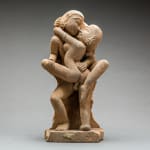Sandstone carved relief of a love-making couple, 13th Century CE
Sandstone
height 30.5 cm
height 12 in
height 12 in
DL.1008
Further images
The Kama Sutra is an ancient Indian text on human sexual behavior, widely considered to be the standard work on love in the Sanskrit literature. The text was written by...
The Kama Sutra is an ancient Indian text on human sexual behavior, widely considered to be the standard work on love in the Sanskrit literature. The text was written by Vatsyayana and the correct full title of the text is vatsyayana kama sutra, "Aphorisms on Love, by Vatsyayana". The author is believed to have lived sometime between the 1st to 6th centuries A.D., probably during the Gupta Empire period.
The Kama Sutra contains a total of 64 sexual positions and depicts positions as arts. Vatsyayana believed there were eight ways of making love, multiplied by eight positions within each of these. In the book, they are known as the 64 Arts.
The chapter listing sexual positions is the most well-known, however, only about 20 percent of the book is devoted to sexual positions. The remainder gives guidance on how to be a good citizen and insights into men and women in relationships. The Kama Sutra describes making love as "divine union" and this relief is intended to capture that.
Some scholars suggest such erotic carvings to be tantric sexual practices. Other scholars state that the erotic arts are part of Hindu tradition of treating kama (desire) as an essential and proper part of human life, and its symbolic or explicit display is common in Hindu temples.
The Kama Sutra contains a total of 64 sexual positions and depicts positions as arts. Vatsyayana believed there were eight ways of making love, multiplied by eight positions within each of these. In the book, they are known as the 64 Arts.
The chapter listing sexual positions is the most well-known, however, only about 20 percent of the book is devoted to sexual positions. The remainder gives guidance on how to be a good citizen and insights into men and women in relationships. The Kama Sutra describes making love as "divine union" and this relief is intended to capture that.
Some scholars suggest such erotic carvings to be tantric sexual practices. Other scholars state that the erotic arts are part of Hindu tradition of treating kama (desire) as an essential and proper part of human life, and its symbolic or explicit display is common in Hindu temples.





